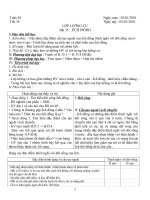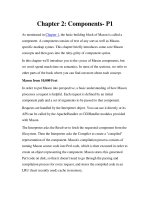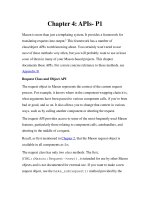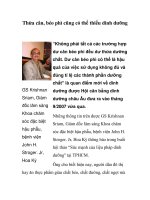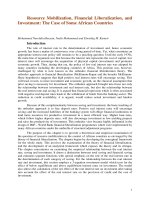Tài liệu Employee Identity in Indian Call Centres: The Notion of Professionalism pptx
Bạn đang xem bản rút gọn của tài liệu. Xem và tải ngay bản đầy đủ của tài liệu tại đây (1.05 MB, 199 trang )
Employee
Identity in Indian
Call Centres
ii Employee Identity in Indian Call Centres
Employee
Identity in Indian
Call Centres
The Notion of Professionalism
Ernesto Noronha
Premilla D’Cruz
Copyright © Ernesto Noronha and Premilla D’Cruz, 2009
All rights reserved. No part of this book may be reproduced or utilized in any form
or by any means, electronic or mechanical, including photocopying, recording or
by any information storage or retrieval system, without permission in writing
from the publisher.
First published in 2009 by
Response Books
Business books from SAGE
B1/I-1 Mohan Cooperative Industrial Area
Mathura Road, New Delhi 110 044, India
SAGE Publications Inc
2455 Teller Road
Thousand Oaks, California 91320, USA
SAGE Publications Ltd
1 Oliver’s Yard, 55 City Road
London EC1Y 1SP, United Kingdom
SAGE Publications Asia-Pacifi c Pte Ltd
33 Pekin Street
#02-01 Far East Square
Singapore 048763
Published by Vivek Mehra for Response Books, typeset in 10.5/12.5 pt Baskerville MT
by Star Compugraphics Private Limited, Delhi and printed at Chaman Enterprises,
New Delhi.
Library of Congress Cataloging-in-Publication Data Available
ISBN: 978-81-321-0079-9 (PB)
The SAGE Team: Reema Singhal, Pranab Jyoti Sarma, Amrita Saha and
Trinankur Banerjee
Contents
List of Tables vi
List of Abbreviations vii
Preface x
Acknowledgements xii
1. Call Centres as Workplaces 1
2. The Call Centre Industry in India 33
3. The Research Process 59
4. Professionalism as Lived Experience 72
5. Professionalism and the Reinvention of the
Trade Union Movement 111
6. Professionalism Contested 131
7. Final Word 157
References 166
Index 179
About the Authors 185
vi Employee Identity in Indian Call Centres
List of Tables
2.1 Indian ITES–BPO Export Revenues 34
2.2 Indian ITES–BPO Employment Levels 43
3.1 Dimensions for Comparing Five Research Traditions
in Qualitative Research 61
3.2 Location of Participants 67
3.3 Gender of Participants 67
3.4 Age of Participants (in years) 67
3.5 Marital Status of Participants 67
3.6 Educational Level of Participants 67
3.7 Monthly Salary of Participants (in Indian Rupees) 67
List of Abbreviations
ACD Automatic Call Distribution
AHT Average Handling Time
AIMA All India Management Association
APESMA Association of Professional Engineers, Scientists
and Managers, Australia
BA Bachelor of Arts
BBC British Broadcasting Corporation
BCom Bachelor of Commerce
BFSI Banking, Financial Services and Insurance
BMA Bangalore Management Association
BOSS Burnout Stress Syndrome
BOT Build-Operate-Transfer
BPO Business Process Outsourcing
BS British Standards
BSNL Bharat Sanchar Nigam Limited
CBPOP Centre for BPO Professionals
CEO Chief Executive Offi cer
CFA Chartered Financial Analyst
CIS Customer Interaction Services
CITU Centre for Indian Trade Unions
CNN Cable News Network
COBIT Control Objectives for Information and related
Technology
COPC Customer Operations Performance Centre
CSR Customer Service Representative
CTC Cost-to-Company
CTI Computer Telephony Integration
DTA Domestic Tariff Area
DVD Digital Versatile Disc
EHTP Electronic Hardware Technology Park
EOU Export-oriented Unit
viii Employee Identity in Indian Call Centres
EU European Union
F&A Finance and Accounting
FDI Foreign Direct Investment
FIET The International Federation of Commercial,
Clerical, Professional and Technical Employees
FTE Full-time Employee
GBP Great Britain Pound
HR Human Resources
HRM Human Resources Management
ICTs Information and Communication Technologies
IDPAD Indo-Dutch Programme for Alternative
Development
IIM Indian Institute of Management
IIT Indian Institute of Technology
IJP Internal Job Posting
ISO International Standards Organization
IT Information Technology
ITES Information Technology-Enabled Services
ITPF IT Professionals’ Forum
ITSM IT Services Management
IVR Interactive Voice Response
JDR Job Demands Resources
KPO Knowledge Process Outsourcing
MBA Master of Business Administration
MNC Multinational Corporation
MTI Mother Tongue Infl uence
NAC NASSCOM’s Assessment of Competence
NASSCOM National Association of Software and Service
Companies
NCR National Capital Region
NRI Non-resident Indian
NSR National Skills Registry
OB Organizational Behaviour
PD Predictive Dialling
PhD Doctor of Philosophy
RBI Reserve Bank of India
Rs Indian Rupee
RSI Repetitive Strain Injury
SEI—CMM Software Engineering Institute—Capability
Maturity Model
SEZ Special Economic Zone
SIF Swedish Union for Technical and Clerical
Employees
SLA Service Level Agreement
SM Shift Manager
SME Small and Medium Enterprise
SSI Software Solutions Integrated
STP Software Technology Park
TC Team Coach
TL Team Leader
TQM Total Quality Management
UK United Kingdom
UNI Union Network International
UNI–APRO UNI–Asia Pacifi c Regional Offi ce
UNITES Union for ITES Professionals
US/USA United States of America
USD US Dollar
VP Vice President
XLRI Xavier Labour Relations Institute
List of Abbreviations ix
Preface
T
his book presents an empirical inquiry, rooted in van Manen’s
hermeneutic phenomenology, describing the work experiences
of Indian call centre agents employed in international facing call
centres located in Bangalore and Mumbai. Through a holistic thematic
analysis, the study identifi es being professional as the core theme that
captures the essence of agents’ lived experience. The notion of pro-
fessionalism embraced agents’ identity, altering their self-concept and
enhancing their self-esteem. According to agents, professionals possess
superior cognitive abilities, advanced qualifi cations and a sense of re-
sponsibility and commitment to work. They prioritize work over
personal needs and pleasure, behaving in a dignifi ed and restrained
manner and performing optimally and rationally while on the job.
Professionals comply with job and organizational requirements,
absorbing emergent strain. Under such circumstances, not only do
agents perceive gains accruing from their job as consistent with the
notion of professionalism but also transactional psychological contracts
of employment as a means of discipline are similarly justifi ed. Though
resistance is displayed by some agents a few times, this is described as a
temporary outlet to ease job-related strain, coexisting with professional
identity—it is not an indicator of anti-work or anti-employer sentiment.
Indeed, agents’ professional identity precludes engagement with col-
lectivization attempts which are seen both as inconsistent with the
essential features of professionalism and as redundant in instances
where employers protect employee interests.
Through agents’ narratives, the context surrounding their pro-
fessional identity came out vividly. Employer organizations cultivated
the notion of professionalism in employees through induction training,
on-going socialization, performance evaluation mechanisms and other
elements of organizational design, in order to gain their compliance
and commitment to the realization of the organization’s agenda. That
professional identity is greatly valued as a symbol of social status
Preface xi
and upward mobility in the Indian context facilitated the process.
Indeed, professional identity allowed agents to accept task and or-
ganizational demands in spite of the strain they engendered. Material
artefacts and organizational processes were cited as proof of an
organization’s espousal of professionalism. Though, in reality, or-
ganizations did not fully deliver on their claims relating to the latter,
professed commitment to employee well-being, rooted in the notion
of professionalism, served organizational interests in maintaining
conducive intra-organizational and extra-organizational environments
that allowed business to fl ourish.
In the attempt to extend the theoretical generalizability of the core
theme, we pursued three courses of action. First, we compared agents’
notion of professionalism with academic literature from the sociology
of the professions. Second, through dialogue with trade unionists and
labour activists, we demonstrated how the nascent collectivist move-
ment in the call centre industry is reinventing itself, keeping in mind
agents’ professional identity and its implications for organizing.
Third, in-depth interviews with call centre managers from Bangalore
and Mumbai pointed out discrepancies between the conceptualization
of professionalism as communicated to and accepted by agents and the
enactment of professionalism within the organization.
Overall, the fi ndings of the study highlight how the inculcation and
internalization of professional identity in call centre agents operates as
a means of socio-ideological control, used by employer organizations
to ensure organizational effectiveness and competitive advantage.
xii Employee Identity in Indian Call Centres
Acknowledgements
T
his book and the research projects that it derives from represent
signifi cant professional and personal milestones for both of us.
Drawing on multiple inquiries rooted in the post-positivist tradition
and experiencing prolonged engagement in the fi eld have enriched our
learning as scholars and sharpened our contribution to related sub-
stantive areas. Working together, facilitated by the convergence of our
ontological and epistemological standpoints, has allowed for a deeper
understanding and evolution of our sense of self, both individually
and jointly.
A large part of the research covered in this book has been funded
by the Indo-Dutch Programme for Alternative Development (IDPAD),
and we are grateful to IDPAD’s Indian and Dutch secretariats, espe-
cially Dr Sanchita Dutta, Rakesh Agrawal, Marc Verhagen and Cora
Govers, for their support.
Numerous research staff contributed to this study including Niss,
Viju, Ganga, Bibhu and Jagadeesh. Pandurangan Rao completed the
transcription meticulously. Our secretaries, Vinodini Raveendran and
Ankur Sumesra, as well as our teaching associates, Bhupinder Arora
and Mukul Kumar, deserve a special mention for their assistance to
us in our various professional responsibilities.
Data collection would have been impossible without the help of
Sam, Amar and Sahitya of ITPF (IT Professional Forum) and N.R.
Hegde, J.S.R. Prasada and Karthik Shekhar of CBPOP/UNITES
(Centre for BPO Professionals/Union for ITES Professionals), and
some of our former students, relatives and friends such as Vinay
Chandra, K.G. Lakshminarayan, Srinivas Seshadri, Abhilash
Nair, Vishal Shah, Gervis D’Souza, Sunder Albuquerque, Anette
D’Cruz and her daughters Neetash and Suchita, Lyndon Alvares,
Noel Duarte, Dilip Mendens, Kanav Kaul, Jaspreet Chandhok,
Anthony Lobo, Vanessa D’Silva, Ninette D’Sa and her daughter
Aneesha and Maurice Pinto. We also thank Mr Ameet Nivsarkar,
Acknowledgements xiii
Vice President, National Association of Software and Service Com-
panies (NASSCOM), for sparing time to talk to us.
Our interactions with Sugata Ghosh, Reema Singhal and Pranab
Sarma of SAGE have been heart-warming.
Finally, but most signifi cantly, our gratitude to our participants
who made the time, as well as trusted us enough, to share their experi-
ences with us, providing us with a crucial window to understand the
complexities of their work lives and workplaces.
1
Call Centres as Workplaces
A
call centre is a specialized offi ce where employees (also known as
agents or customer service representatives [CSRs] and referred
to as such in this book) remotely provide information, deliver services,
and/or conduct sales, using some combination of integrated telephone
and information technologies, typically with an aim to enhancing custo-
mer service while reducing organizational costs (McPhail, 2002: 10).
Call centres epitomize many of the characteristics of service work that
have come to dominate developed economies (Deery and Kinnie,
2004), providing an intangible, perishable product which is highly
variable and engages the customer in its production (Korczynski, 2002).
However, distinctively, call centres require their employees to be skilled
at interacting directly with customers while simultaneously working
with sophisticated computer-based systems that dictate the pace of their
work and monitor its quality (Deery and Kinnie, 2004).
Call centre development is situated at the intersection of rapidly
expanding information and communication technologies (ICTs),
reengineered business processes, a changing (or changed) profi le
of customer needs and expectations and a prevailing culture of oc-
cupational restructuring (Houlihan, 2000). The introduction of
information technologies and telecommunications advances has ex-
panded the types of work it is possible to undertake, while reducing
costs. The transformation of telephony by the development of digital
exchanges, intelligent telephone networks and their integration with
computer databases; falling telephony costs and the introduction of
toll-free numbers; the high degree of penetration and familiarity
of telephone technology; and the ability to communicate complex
2 Employee Identity in Indian Call Centres
information by phone in real time (Richardson and Marshall, 1999),
have spearheaded this process.
Another reason for the burgeoning of the call centre industry is a
drive towards reducing costs and cutting staff, both of which can be
accomplished by centralizing services, reducing branch offi ces close
to the customer, and taking advantage of lower cost real estate and
labour costs in locations outside main business centres (Richardson
and Marshall, 1999). The centralization of service provision has enabled
fi rms to rationalize the work process through the extensive use of ICTs
thereby maximizing the use of agents’ time. The standardization of
service encounters with customers and the use of functionally equivalent
and interchangeable service providers have also helped call centres
to achieve great speed and effi ciency in the delivery of their services
(Gutek, 1995). This is furthered by technological developments which
allow for the disentanglement of time and place for both individuals
and organizations. Companies can concentrate their customer infor-
mation desk in a particular country and automatically route calls
from a number of countries to this centre, without customers having
to know that he/she is calling long distance or internationally. As a
result, companies have begun to move some of their labour intensive
operations to low wage countries (Dormann and Zijlstra, 2003),
sparking off the offshoring trend.
Various facets of employee experiences of working in call centres
have received research attention. In the West and in Australia, nu-
merous inquiries examining a range of substantive areas such as skills
and training, career development, emotional labour, strain and well-
being, control, resistance, and collectivization have been undertaken.
Chapter 1 presents the fi ndings of these studies in two broad sections,
namely, work context and requirements and the impact of work
on employees, thereby providing a view of call centres as workplaces.
In India, where the call centre industry forms part of the Information
Technology Enabled Services–Business Process Outsourcing (ITES–
BPO) sector, empirical inquiries are fewer in number and limited in
focus. Here, research on employee experiences largely embraces the
labour process perspective, giving a broad overview of job design, work
systems and work context and their impact on employees set against a
backdrop of offshoring and cross-cultural issues. Chapter 2 discusses
the Indian scenario.
Call Centres as Workplaces 3
Work Context and Requirements
While call centres could operate either as independent organizations
or as departments within larger organizations that are specifi cally
dedicated to contacting clients and customers, they fall into two broad
categories, namely, inbound and outbound call centres (Dormann
and Zijlstra, 2003). Inbound call centres receive incoming calls from
customers and prospective customers, with the goal of providing
information, services or technical support. Outbound call centres
include a variety of functions, the most common of which are survey
research, fund-raising, collections and telemarketing (see McPhail,
2002, for a detailed discussion).
Work Systems and Job Design
Call centres are the result of a modern rationalization process
(Dormann and Ziljstra, 2003) and represent a high degree of division
of labour (Grebner et al., 2003). Though this has implications for job
design and work systems, it does not translate into all call centre jobs
lacking variety, complexity and autonomy. While this may be true of
some groups, there are other instances of tasks which embody variety,
complexity and autonomy in spite of high grade division of labour. It
is not surprising, therefore, that the literature on call centres distin-
guishes between two models, underscoring that the description of call
centres as ‘electronic sweatshops’ (Garson, 1988), ‘twentieth-century
panopticons’ (Fernie and Metcalf, 1998) and ‘assembly lines in the
head’ (Taylor and Bain, 1999) is an overgeneralization and over-
simplifi cation (Dormann and Ziljstra, 2003).
The mass service/engineering model (Holman, 2003) emphasizes
factory-like division of labour (Taylor and Bain, 1999; van den Broek,
2004), with jobs being characterized as dead-end, with low com-
plexity, low control, repetition and routineness as well as low status,
poor pay and few career prospects (Deery and Kinnie, 2004; Knights
and McCabe, 1998; Taylor and Bain, 1999). Call centre agents
are mouthpieces often following scripted dialogues and detailed in-
structions and enjoying little autonomy (Knights and McCabe, 1998).
Tasks have been simplifi ed, services must conform to pre-determined
design specifications and the production process has been con-
structed to minimize labour costs (Deery and Kinnie, 2004).
4 Employee Identity in Indian Call Centres
In contrast, the high commitment service model (Holman, 2003)
includes jobs entailing complexity and control for employees who
must interpret information and use their judgement to provide in-
dividually-customized solutions to customers whose requirements
are more complex and demand specialized servicing. Here, jobs pro-
vide challenge and interest and the skills of front-line workers are
acknowledged and valued. In such cases, customers’ requirements
cannot easily be standardized and workers require fl exibility and dis-
cretion in negotiating their interactions with customers (Deery and
Kinnie, 2004; Frenkel et al., 1998; Leidner, 1996).
The nature of the service being provided as well as the organization’s
business objectives determine the model that is adopted (Batt, 2001).
This, in turn, according to Batt (2000); Deery et al. (2004); Gutek
(1995) and Purcell and Kinnie (2000) determines the management
of the labour/human resource process, which becomes the pro-
duction line in the case of the mass service/engineering model and
empowerment in the case of the high commitment model (Bowen and
Lawler, 1992).
Yet others argue that the aforementioned process of determin-
ation is simple, direct and linear, failing to refl ect reality because most
call centres seek to be simultaneously cost-effi cient and customer-
oriented (Korczynski, 2002). Frenkel et al. (1998) hold that the truth
lies somewhere in between, with elements of both views coexisting.
In their view, the management has to adopt a form of organization
which reconciles the two confl icting principles, that is, standardization
of processes and products aimed at lowering unit costs through scale
and transaction economies; and customization aimed at generating
revenue by focusing on individual customer requirements (Frenkel
et al., 1998). Kinnie et al. (2000), following the same perspective, reject
the simplicity argument that call centres are either dark satanic mills
or the home of empowered workers. They highlight the existence of
a paradox of tightly controlled, heavily monitored and scripted work
juxtaposed with high commitment practices (Kinnie et al., 2000).
Undoubtedly, then, most call centres espouse a strong desire to achieve
low customer-waiting times and to minimize call handling and wrap-up
time as well as providing high quality service (Deery et al., 2004).
Korczynski (2002) maintains that these twin objectives are fun-
damentally contradictory. On the one hand, organizations seek to
Call Centres as Workplaces 5
reduce costs per customer transaction by increasing the speed with
which calls are processed, yet on the other hand they extol the virtues
of customer service and encourage their employees to be quality-
oriented. Mulholland (2002) refers to this as an attempt to combine a
lean production model with a soft discourse of caring and quality. Her
research, however, fails to fi nd a genuine and sustained commitment to
this language of quality. Indeed, as Herzenberg et al. (1998) show, the
application of a mass engineering/service model to service provision
seriously undermines the quality of the service interaction while, as
Shire et al. (2002) indicate, the need to be customer-oriented imposes
real limits on the degree of service standardization. What further com-
plicates the process is the fact that attempts to deliver service according
to a predetermined design and to routinize customers’ behaviour
may not always be possible because of the diffi culties of removing all
uncertainty from customer–agent interactions (Deery et al., 2004).
The tensions and contradictions of these two logics of having to
be cost-effi cient and customer-oriented and the attempt to reconcile
and balance them have implications for organizations, employees and
customers (Deery and Kinnie, 2004; Deery et al., 2004; Hutchinson
et al., 2000; Korczynski, 2002). Stated simply, organizations are at-
tempting to personalize their service while at the same time seeking
to reduce the cost per transaction. Employees work towards satisfying
employer demands, being guided by the performance indicators they
are evaluated on while trying to fi nd meaning in their work, reduce
strain and enhance well-being. Customers are seeking to obtain services
that are adapted to their needs and requirements yet at the same time
are inexpensive and can be supplied effi ciently. The mass customized
bureaucracy model is proposed to represent this complex, hybridized
reality (Frenkel et al., 1998). Here, bureaucracy is retained but has
elements associated with professional or knowledge-intensive settings
appropriate to the customization of products and services (Knights
and McCabe, 1998). Similarly, Batt and Moynihan (2002) put forward
the mass customization model where the emphasis is both on being
cost-effi cient and on satisfying customers.
The Role of Skills
Task performance in call centres requires employees to sit at a table
in front of a computer, wearing a headset to communicate with the
6 Employee Identity in Indian Call Centres
customer and leaving their hands free to enter data into the computer,
if needed (Zapf et al., 2003). Though there is an overriding popular
perception that call centre jobs are simple and routine, in reality, they
entail many complex roles and skill demands (Houlihan, 2000). Rose
and Wright (2005) maintain that call centre work is skilled work, though
the specifi c skills required vary between industry sectors, nature of job
being performed, and business purpose and model of the organization.
Belt et al. (2000) found that fi nancial services fi rms typically provided
a narrow range of tasks, resulting in employee frustration at being
unable to really use existing skills or develop new ones. Similarly,
Stanworth (1997: 58) suggests that banks in particular are ‘creating
a new deskilled workforce in (call) centres, where there is no longer a
need for qualifi cations’ and workers are expected to function with as
little as three weeks of training. Alternatively, agents in the computer
services industry, who perform specialized technical roles, exercise the
greatest range of skills as they require specialized technical expertise as
well as the same kind of communication skills needed in all call centres
to perform their work (Belt et al., 2000).
Dormann and Zijlstra (2003) and Frenkel et al. (1998) also underscore
that jobs in call centres call for different levels of qualifi cation ranging
from people with simple skills who provide standard information
(sometimes even reading from prescribed scripts) to frequently asked
questions to highly qualifi ed personnel who deal with unique complex
problems.
Belt et al. (2000) take the argument further, holding that even in
instances where call centre agents are performing a relatively narrow
range of tasks, they work ‘extensively and intensively’ on the telephone.
Many agents, supervisors and managers included in their study were
keen to emphasize that call centre work was skilled. Despite the repeti-
tive and standardized nature of much of their work, the majority of
agents emphasized that certain sets of skills and competencies were
required in call centre work. In particular, they stressed the expertise
involved in handling customers professionally yet also effi ciently and
under strict time pressures. Related to this, agents highlighted the skill
involved in conveying the right image to the public over the telephone.
In addition, agents underscored the elements of discretion and res-
ponsibility involved in their work (Belt et al., 2000). Similarly, with
regard to computer skills, though the skills called for here are generally
Call Centres as Workplaces 7
not highly technical or specialized, but involve operating the computer,
performing data entry and accessing and moving between databases,
navigation provides no small challenge since agents must work under
time pressure while simultaneously maintaining conversation to prevent
‘dead air’ with the customer and manipulating the information system
(McPhail, 2002).
Skill development constitutes an important activity in call centres
and hence it is a common pattern to provide relatively long introductory
training periods compared to other types of clerical work. In fact,
agents themselves claim that the training they received upon being
hired in a call centre was longer and more thorough than what they
had received for previous jobs (Belt et al., 2002). Training may consist
of a range of skills, including communication and customer service
skills, sales skills, product knowledge and systems orientation. The
particular elements provided in the training depend on the type of
call centre, the range of tasks which will be performed, and the length
of training time. While information technology (IT) training is often
the most limited, an orientation to organizational culture forms an
important component (Buchanan and Koch-Schulte, 2000). While
the duration of training varies between two to six weeks (McPhail,
2002), the attempt is to make training programmes longer and reduce
turnover (Belt et al., 1999b).
The debate surrounding the skills entailed in call centre work is
complicated by two factors, namely, on-the-job skill development and
insider–outsider views. Belt et al. (2002: 28) state that ‘the nature of work
organization used in call centres acts to constrain skill development’.
Agents use words like ‘repetitive’, ‘tiring’ and ‘stressful’ in describing
working on the phones all day, comparing their jobs to assembly lines.
Moreover, while they developed their ‘people skills’ and appreciated
the training they received in this area when beginning the job, agents
felt that they had not actually learned new skills while working in call
centres (Belt et al., 2002). Buchanan and Koch-Schulte (2000: 54)
support this view, stating that ‘employees leaving call centres are not
more fully prepared for other, more challenging types of employment
because they are not ordinarily expected to utilize more than basic
keyboarding skills, and the communication and interpersonal skills
that they do acquire are undervalued’.
8 Employee Identity in Indian Call Centres
The insider–outsider dichotomy underscores that while there is
often internal recognition within call centres of the specifi c skill set
needed for the job, these skills are not suffi ciently valued by those
outside the call centre context, neither in the call centres’ parent
organization nor in the general public (Belt et al., 2000). Ironically,
the skills that tend to be least valued outside the call centre are those
which are claimed to be most critical for task performance within it
(McPhail, 2002), as illustrated by Belt et al. (1999b) who found in their
study of 100 European call centres that call centre managers con-
sidered communication skills and customer service skills to be the most
important skills for any call centre employee. Outsider views appear to
stem both from popular perceptions that such attributes are essentially
natural talents rather than valuable skills and form the invisibility of
such work (McPhail, 2002).
The Centrality of Emotional Labour
Task execution in call centre work necessarily involves emotional
labour, performed in remote mode and cutting across specifi c models
and tasks. During service transactions, employees are expected to smile
down the telephone (Belt et al., 1999a), that is, they are expected to
display emotions that comply with certain norms or standards of the
organization which are designed to create a desired state of mind in
the customer (Deery et al., 2002). Equally important, they have to
represent their organization and its values and customer orientation
to the customers, such that an indelible positive impression is left
behind. Employees are expected to appear happy to serve the customer
in spite of whatever private misgivings or feelings they may have
(Erickson and Wharton, 1997). As Thompson et al. (2001) found, the
most critical skills in call centres were not technical but social. Thus,
apart from computer skills and product knowledge, capabilities such
as the ability to remain calm amid pressure and the ability to main-
tain a friendly, positive and tactful attitude while at the same time being
psychologically disengaged in instances of rude and abusive customers;
as well as empathy and the ability to ascertain customer mood and
requirements are greatly valued (Frenkel et al., 1998; Rose and Wright,
2005). Call centre employees are not simply expected to execute their
physical tasks competently and effi ciently and to display knowledge
Call Centres as Workplaces 9
of their organization’s products, procedures or practices (Deery and
Kinnie, 2004), they also have to adhere to clear rules about how to
interact with customers (Zapf et al., 2003), being expected to display
emotions that help create a desired ‘state of mind’ in the customer
(Deery and Kinnie, 2004), even if they have to express emotions they
do not feel (such as being friendly or happy) or suppress emotions
that they genuinely do feel (such as anger or frustration) at a point
in time. Sensitivity requirements (Zapf et al., 1999), complicated by
the absence of face-to-face interaction and visual cues, are also called
into play. In other words, call centre employees are held accountable
for their emotions (Hochschild, 1983) and emotional labour is used
to manufacture relationships (Macdonald and Sirianni, 1996). At the
same time, it is being increasingly recognized not only that emotional
labour in call centres can be impaired by tightly scripted dialogues
and routinized responses (Deery and Kinnie, 2004; Taylor and Bain,
1999), but also that customer participation in the service encounter
brings uncertainty and complexity into the labour process. Although
management may wish to standardize the behaviour of customers
and limit their options, it is not always possible to achieve predictability
and compliance in the service exchange. Where customers’ require-
ments cannot easily be standardized, agents will require some degree
of fl exibility and discretion in negotiating their interactions with
customers. This has implications for task execution, for the evaluation
of agent performance, for the achievement of organization objectives,
and, depending on how the situation is handled, for customer satisfac-
tion (Deery et al., 2004).
The skills relied upon in emotional labour and customer interaction
emphasize a feminine orientation of caring, passivity, communicating
and making people feel good. Belt et al. (2002) quote studies to highlight
that demand for female labour power in service-based economies is
increasing because of this belief and that stereotypical feminine qual-
ities are much sought after employment assets. Employers admit to
recruiting women based on the assumption that they are better able
to perform this kind of work: ‘Call centre employers expect women
to perform emotional labour over the phone, and they actively use
femininity in order to secure competitive advantage’ (Belt et al., 2002:
26–27). Women agents concur with this stand, indicating that they
used their femininity at work, particularly when dealing with male
customers (Belt et al., 2002).
10 Employee Identity in Indian Call Centres
Though the implications of emotional labour performance for
employees across various occupations remains a contested issue,
there is limited data available about the call centre setting. Lewig
and Dollard’s (2003) work on emotional labour in call centres con-
fi rms the pre-eminence of emotional dissonance compared to other
dimensions of emotional labour (such as the display of positive
emotions, display of negative emotions and demand for sensitivity) in
infl uencing emotional exhaustion and job satisfaction. Thus emotional
demands at work do not directly lead to emotional exhaustion but do
so through their relationship with emotional dissonance. Emotional
dissonance exacerbates emotional exhaustion at high levels of psycho-
social work demands, indicating that high levels of both are risky.
Lewig and Dollard (2003) found that the potential ways of alleviating
emotional exhaustion and enhancing job satisfaction is to increase
rewards (money, status and esteem), autonomy (skill discretion and
decision authority) and support (from co-workers and supervisors) as
well as to reduce psychosocial demands. Deery et al.’s (2002) research
implicates the role of emotional labour and customer interaction in
precipitating emotional exhaustion in call centre agents. Their work
specifi cally pointed out to the experience of customer insensitivity and
abuse, the use of scripts and the emphasis on turnaround time and
quantity of calls.
Customers provide both joy and sadness to call centre employees,
exemplifying Benson’s (1986) claim that customers are both the
friend and the enemy. While irate customers are systematic parts
of social relations in service work (Deery et al., 2002; Korczynski,
2003). Korczynski (2003) shows that abuse and hostility are likely
to be higher in telephonic interactions due to the absence of face-
to-face contact or physical proximity and that irate customers upset
agents, precipitating dejection and low morale. The manner in which
agents are trained to handle irate customers is in keeping with
Korczynski’s (2003) observation that management knew how em-
ployees felt, but they expected them to put up with the abuse to
keep business going. Thus, reacting negatively to irate customers
would result in punishments for the employees. Management gives
employees various mechanisms to cope with irate customers. In terms of
cognitive restructuring, employees were told that they could maintain
their hold over the situation by the way in which they looked at the
Call Centres as Workplaces 11
situation—they should remove themselves from the situation and not
take the customer personally (Frenkel et al., 1998; Korczynski, 2003).
However, Wharton (1993) cautions that this disjuncture between what
employees might feel towards their customers and what they are
expected to display could be diffi cult to resolve and could precipitate
severe anxiety.
Among the other options pointed out by management, Korczynski
(2003) highlights the development of communal rituals which cele-
brated the pleasures of customer contact, indicating that it was worth
putting up with some pain in order to get some gains. In addition,
management also understood the relevance of communities of coping
where employees sought support from each other to deal with the
strain of irate customers (Korczynski, 2003). But as Noon and Blyton
(1997: 140) caution, these groups serve as a curious mixture of consent
and resistance to work. By helping agents to survive the tensions of their
work, these communities preserve the social order of the workplace
and reduce employee turnover, facilitating management requirements.
At the same time, they can develop into strong informal subcultures
that provide resistance and make workplace relations diffi cult for
management to control.
Monitoring, Surveillance and Control
Control, often euphemistically termed as coordination, which is in-
tegral to organizational functioning and effectiveness (Hatch and
Cunliffe, 2006), operates via technobureaucratic and normative/cul-
tural/socio-ideological mechanisms in call centres. The ICTs, namely
the automatic call distribution (ACD) and predictive dialling (PD)
systems,
1
that form the basis of call centre operations set the stage
1
The ACD system automatically processes incoming telephone calls and distributes
them to agents’ headsets while simultaneously generating a constant stream of up to
200 sets of statistics about the activities it coordinates including call volume, duration,
wrap times, wait times and abandonment rates at the call centre, the team and the
individual agent levels. Not only does the ACD system set the pace of work and monitor
performance, but managers and supervisors can also view these statistics, as they are
generated in real time, on their desktop computers, and can track each employee’s
activities throughout the day. Aggregate information from the ACD can also be made
available to everyone in the call centre, via displays on large electronic display boards
throughout the offi ce. Often ACD systems are connected to one or more databases
using computer telephony integration (CTI) software, which allows for customer
